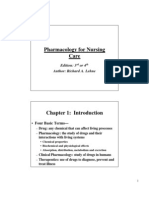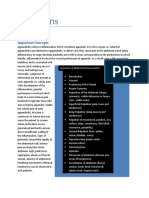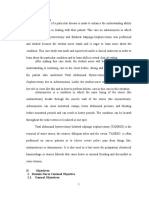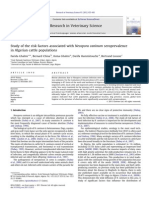Understanding IV Fluids
Understanding IV Fluids
Uploaded by
Joe Anne Maniulit, MSN, RNCopyright:
Available Formats
Understanding IV Fluids
Understanding IV Fluids
Uploaded by
Joe Anne Maniulit, MSN, RNOriginal Description:
Copyright
Available Formats
Share this document
Did you find this document useful?
Is this content inappropriate?
Copyright:
Available Formats
Understanding IV Fluids
Understanding IV Fluids
Uploaded by
Joe Anne Maniulit, MSN, RNCopyright:
Available Formats
nursingelement.
com
http://w w w .nursingelement.com/student-resources/understand-osmosis/
Understanding IV Fluids
I cannot describe to you how pictures make things click, but they do! When my friend drew a pic to describe osmosis, a major light bulb went off and this concept remained stuck in my head and truly helped me with IV fluids. For instance, if your patient is dehydrated what will be the ideal IV fluid replacement? the answer is hypotonic because you need to bring water or hydration back into the cells: Seeing the IV Fluids This is a more presentable graphic than what my friend made in my notebook nonetheless what was microscopic to understand was suddenly clear! and my little advice is if youre confused about IV rehydration and how they relate to the body, please keep this picture in your head, thanks
More Examples * 0.33% sodium * lower tonicity or solute chloride concentration Hypotonic * 0.2% * fluids shift from the (big blood sodium intravascular space to cell) chloride both the intracellular and * 2.5% interstitial spaces dextrose in water * concentration of dissolved particles is similar to that of plasma Isotonic Lactated * infused solutions (normal Ringer's remain in the blood cell) solution extracellular space and increase intravascular volume * 3% sodium chloride * 5% sodium chloride * 5% * higher tonicity or solute dextrose concentration Hypertonic and 0.45% * water is drawn out of (small sodium the intracellular space, blood cell) chloride increasing extracellular * 5% fluid volume dextrose and 0.9% sodium chloride * D5LR * D20W * D50W Definition
Type of Fluid
An Summary of Body Fluids by Nursing Center Two main fluid compartments Fluids within the body are contained in two basic compartments, intracellular and extracellular. Cell membranes and capillary walls separate the two fluid compartments. The intracellular fluid compartment, which consists of fluid contained within all of our body cells, is the larger of the two compartments. The extracellular fluid compartment contains all the fluids outside the cells and is further divided into two major subcomponents: intravascular fluid contained in blood vessels and interstitial fluid found in the tissue spaces. The intracellular, intravascular, and interstitial spaces are the major fluid compartments in the body. A third category of the extracellular fluid compartment is the transcellular compartment, which includes cerebrospinal fluid and fluid contained in body spaces such as the pleural cavity and joint spaces. Because transcellular fluids dont normally contribute significantly to fluid balance, theyre beyond the scope of this article. How much of you is water? The amount of water in the body varies depending on age, gender, and body build. In nonobese adults, intracellular fluid constitutes approximately 40% of body weight, and extracellular fluid, 20%. Lean body muscle mass is rich in water, while adipose tissue has a lower percentage of water content. Because of this, someone whos overweight or obese has a lower percentage of water overall compared with someone whos lean and muscular. Similarly, women typically have a lower percentage of total body water than men due to a higher percentage of body fat. Older adults tend to have a lower concentration of water overall, due to an age-related decrease in muscle mass. Conversely, children tend to have a higher percentage of water weight-as much as 80% in a full-term neonate. Fluids dont remain static within body compartments; instead, they move continuously among them to maintain homeostasis. Cell membranes are semipermeable, meaning they allow fluid and some solutes (particles dissolved in a solution) to pass through. Fluids and electrolytes move between compartments via passive and active transport. Passive transport occurs when no energy is required to cause a shift in fluid and electrolytes. Diffusion, osmosis, and filtration are examples of passive transport mechanisms that cause body fluid and electrolyte movement. Osmolality and osmolarity are two similar terms that are often confused. Osmolality, which is usually used to describe fluids inside the body, refers to the solute concentration in fluid by weight: the number of milliosmols (mOsm) in a kilogram (kg) of solution. Osmolarity refers to the solute concentration in fluid by number of mOsm per liter (L) of solution. Because 1 L of water weighs 1 kg, the normal ranges are the same and the terms are often used interchangeably. Changes in the level of solute concentration influence the movement of water between the fluid compartments. The normal osmolality for plasma and other body fluids varies from 270 to 300 mOsm/L. Optimal body function occurs when the osmolality of fluids in all the body compartments is close to 300 mOsm/L. When body fluids are fairly equivalent in this particle concentration, theyre said to be isotonic. Fluids with osmolalities less than 270 mOsm/L are hypotonic in comparison with isotonic fluids, and fluids with osmolalities greater than 300 mOsm/L are hypertonic. Tonicity of I.V. fluids will be discussed in detail later in this article. Through the use of mechanisms such as thirst, the renin-angiotensin-aldosterone system, antidiuretic hormone, and atrial natriuretic peptide, the body works to maintain appropriate fluid and electrolyte levels and to prevent imbalances within the body. When an imbalance occurs, you must be able to identify the cause of the problem and monitor the patient during treatment. Source: IV Fluids What Nurses Need to Know, Nursing 2011, 5/11 volume 41, number 5 pages 30-38
You might also like
- Case Study 25Document3 pagesCase Study 25Desiree Ladner Scott86% (7)
- BIOL 2905 Quiz 2 Immunology BasicsDocument6 pagesBIOL 2905 Quiz 2 Immunology BasicsShafeeq ZamanNo ratings yet
- Intravenous Therapy For BSN StudentsDocument30 pagesIntravenous Therapy For BSN StudentsKevin Cervantes FernandezNo ratings yet
- Case Analysis 5Document3 pagesCase Analysis 5Ivy LupacNo ratings yet
- Respiratory ModalitiesDocument87 pagesRespiratory ModalitiesLj Ferolino100% (2)
- Copd Case StudyDocument6 pagesCopd Case StudyDivine ParagasNo ratings yet
- Acute PainDocument1 pageAcute Painnursing concept mapsNo ratings yet
- Neuroscience: Science of The Brain in MandarinDocument72 pagesNeuroscience: Science of The Brain in MandarinInternational Brain Research OrganizationNo ratings yet
- Thorax McqsDocument23 pagesThorax McqsBassamSheryanNo ratings yet
- IV Fluids (What Nurses Need To Know)Document9 pagesIV Fluids (What Nurses Need To Know)ChelseaLovell100% (2)
- Concept Map FinalDocument1 pageConcept Map Finalapi-383763177No ratings yet
- ECG PlacementDocument2 pagesECG Placementvin_XVIIINo ratings yet
- Perioperatif Nursing PDFDocument93 pagesPerioperatif Nursing PDFNurvanny HusnaNo ratings yet
- Multiple Organ Dysfunction Syndrome: Contemporary Insights On The Clinicopathological SpectrumDocument16 pagesMultiple Organ Dysfunction Syndrome: Contemporary Insights On The Clinicopathological SpectrumNurul Kamilah SadliNo ratings yet
- Intravenous FluidDocument3 pagesIntravenous FluidMary Anthonette Arenas EstradaNo ratings yet
- 2 Acute Myocardial InfarctionDocument15 pages2 Acute Myocardial InfarctionpauchanmnlNo ratings yet
- Perioperative Nursing Overview HandoutDocument15 pagesPerioperative Nursing Overview HandoutRebecca BautistaNo ratings yet
- Group 5 - Hemodialysis - Chronic Kidney FailureDocument31 pagesGroup 5 - Hemodialysis - Chronic Kidney FailureKimberly Abella CabreraNo ratings yet
- IV Fluid CalculationDocument7 pagesIV Fluid Calculationemyjones0% (1)
- Camporedondo, Bryan C. RLE8 - Group5 Emergency Drugs: Atropine SulfateDocument4 pagesCamporedondo, Bryan C. RLE8 - Group5 Emergency Drugs: Atropine SulfateIglesia Ni Cristo DoctorsNo ratings yet
- Clinical Procedures For Safer Patient Care: Chapter 8. Intravenous TherapyDocument54 pagesClinical Procedures For Safer Patient Care: Chapter 8. Intravenous TherapyGladys YaresNo ratings yet
- Perioperative Nursing Concept PDFDocument21 pagesPerioperative Nursing Concept PDFMari Fe100% (1)
- m2 Pharmacology Handout 8-25-21Document7 pagesm2 Pharmacology Handout 8-25-21Sheila May SantosNo ratings yet
- Pharmacology For Nursing. Richard A. LehneDocument62 pagesPharmacology For Nursing. Richard A. LehneJC Ortiz-Carrillo50% (2)
- Drug Study ICUDocument15 pagesDrug Study ICUJulie Nambatac100% (1)
- Triage NurseDocument1 pageTriage NurseJeyser T. GamutiaNo ratings yet
- Drug Card MotrinDocument2 pagesDrug Card MotrinAdrianne BazoNo ratings yet
- Procedures For Administering Injectable Drugs: Version No 2Document201 pagesProcedures For Administering Injectable Drugs: Version No 2farklinRSBKNo ratings yet
- MM M M MDocument20 pagesMM M M MAshok KumarNo ratings yet
- GI Disorders NursingDocument93 pagesGI Disorders NursingAmy100% (4)
- Drops Per Minute Reference ChartDocument1 pageDrops Per Minute Reference ChartChiara FajardoNo ratings yet
- Scope and Practice of Emergency NursingDocument15 pagesScope and Practice of Emergency NursingLouis Justin E. ArevaloNo ratings yet
- Nanda Needs ListDocument24 pagesNanda Needs ListObrian ReidNo ratings yet
- Nursing Care PlanDocument22 pagesNursing Care Planaln00550% (2)
- Central Venous Pressure Monitoring: Assisting With CVP PlacementDocument3 pagesCentral Venous Pressure Monitoring: Assisting With CVP PlacementGlare RhayneNo ratings yet
- Learning Objective: - Explain of Acute AbdomenDocument143 pagesLearning Objective: - Explain of Acute AbdomenSamuel Sebastian SirapanjiNo ratings yet
- RocuroniumDocument1 pageRocuroniumSuresh KumarNo ratings yet
- Heart Failure COncept MapDocument2 pagesHeart Failure COncept MapJrBong Semanero100% (1)
- Patho Worksheet Right Heart FailureDocument1 pagePatho Worksheet Right Heart FailureMindy Leigh LayfieldNo ratings yet
- RENAPDocument2 pagesRENAPKristopher JacintosNo ratings yet
- Tracheostomy Care - An Evidence-Based Guide - American Nurse TodayDocument4 pagesTracheostomy Care - An Evidence-Based Guide - American Nurse TodayZulaikah Nur IstiqomahNo ratings yet
- Appendicitis (History & Examination)Document6 pagesAppendicitis (History & Examination)Doctor Saleem Rehman75% (4)
- Nursing Care Plans For Activity IntoleranceDocument3 pagesNursing Care Plans For Activity Intoleranceravenshadow100% (2)
- CASE SCENARIO 3 PreopDocument3 pagesCASE SCENARIO 3 PreopEdgarNo ratings yet
- PotassiumDocument2 pagesPotassiumNinoska Garcia-Ortiz100% (18)
- DischargeDocument49 pagesDischargejonel_amarille100% (1)
- Care Plan For CHFDocument6 pagesCare Plan For CHFclarimerNo ratings yet
- Visual Acuity Test: Presented by Sushma Shrestha Roll No 38Document20 pagesVisual Acuity Test: Presented by Sushma Shrestha Roll No 38sushma shresthaNo ratings yet
- Pulmonary EmbolismDocument4 pagesPulmonary Embolismemmag1221100% (1)
- Ms Ellaine Boo Role of Trauma NursingDocument35 pagesMs Ellaine Boo Role of Trauma NursingBrunoNo ratings yet
- Nursing Care Plan FinalDocument4 pagesNursing Care Plan FinalSheana TmplNo ratings yet
- Ball Ch04 LectureDocument102 pagesBall Ch04 Lecturenurseleon100% (2)
- Module 4 Nursing ProcessDocument14 pagesModule 4 Nursing ProcessArjay Cuh-ingNo ratings yet
- Research FinalDocument7 pagesResearch Finalapi-451587482No ratings yet
- The Ride of Your Life: What I Learned about God, Love, and Adventure by Teaching My Son to Ride a BikeFrom EverandThe Ride of Your Life: What I Learned about God, Love, and Adventure by Teaching My Son to Ride a BikeRating: 4.5 out of 5 stars4.5/5 (2)
- Nursing care process in patients with chronic obstructive pulmonary diseaseFrom EverandNursing care process in patients with chronic obstructive pulmonary diseaseNo ratings yet
- How to Succeed New Graduate Nursing Job Interview & Bachelor of Nursing Clinical Placement?From EverandHow to Succeed New Graduate Nursing Job Interview & Bachelor of Nursing Clinical Placement?No ratings yet
- Ebstein Anomaly, A Simple Guide To The Condition, Diagnosis, Treatment And Related ConditionsFrom EverandEbstein Anomaly, A Simple Guide To The Condition, Diagnosis, Treatment And Related ConditionsNo ratings yet
- Intravenous Therapy Administration: a practical guideFrom EverandIntravenous Therapy Administration: a practical guideRating: 4 out of 5 stars4/5 (1)
- Notes On Buying Behavior 5112 Week 2Document7 pagesNotes On Buying Behavior 5112 Week 2Joe Anne Maniulit, MSN, RNNo ratings yet
- Behavioral ObjectivesDocument28 pagesBehavioral ObjectivesJoe Anne Maniulit, MSN, RN50% (2)
- Pregnancy Induced Hypertension Case StudyDocument77 pagesPregnancy Induced Hypertension Case StudyJoe Anne Maniulit, MSN, RN84% (49)
- Generic Name (Brand Name) Classification Dosage Indication/ Contraindication Nursing ResponsibilitiesDocument3 pagesGeneric Name (Brand Name) Classification Dosage Indication/ Contraindication Nursing ResponsibilitiesJoe Anne Maniulit, MSN, RNNo ratings yet
- High-Risk Pregnancy Pregnancy-Induced Hypertension (PIH) What IsDocument6 pagesHigh-Risk Pregnancy Pregnancy-Induced Hypertension (PIH) What IsJoe Anne Maniulit, MSN, RNNo ratings yet
- Myoma Case StudyDocument78 pagesMyoma Case StudyJoe Anne Maniulit, MSN, RN79% (14)
- Delivery Room Drug StudyDocument12 pagesDelivery Room Drug StudyJoe Anne Maniulit, MSN, RN100% (6)
- Thesis (Effect of Curcuma Longa On Human Sebum Secretion)Document18 pagesThesis (Effect of Curcuma Longa On Human Sebum Secretion)Jolaine ValloNo ratings yet
- Conservat Sci and Prac - 2022 - Carrete - Emerging Laws Must Not Protect Stray Cats and Their ImpactsDocument3 pagesConservat Sci and Prac - 2022 - Carrete - Emerging Laws Must Not Protect Stray Cats and Their ImpactsVeronica MartinezNo ratings yet
- 19 The Burgess Animal Book For ChldrenDocument5 pages19 The Burgess Animal Book For ChldrenlaurkeNo ratings yet
- Restructured Meat Products - Production, Processing and Marketing: A ReviewDocument14 pagesRestructured Meat Products - Production, Processing and Marketing: A ReviewPratiwi RahmanNo ratings yet
- Ilppa Pre-AssessmentDocument3 pagesIlppa Pre-Assessmentapi-458755440No ratings yet
- Hubungan Kepatuhan Minum Obat Anti Tuberkulosis Dengan Status Gizi Anak Penderita Tuberkulosis ParuDocument29 pagesHubungan Kepatuhan Minum Obat Anti Tuberkulosis Dengan Status Gizi Anak Penderita Tuberkulosis ParuWewen AnggariniNo ratings yet
- Peta - Go VeganDocument24 pagesPeta - Go VeganDiego Deitos100% (2)
- Anatomy StomachDocument43 pagesAnatomy StomachBijo K BennyNo ratings yet
- Thermal and AnesthesiaDocument11 pagesThermal and AnesthesiaancillaagraynNo ratings yet
- Lesson1-Types of SentencesDocument7 pagesLesson1-Types of SentencesAb DouNo ratings yet
- Biology Punnett Square Packet 2012Document13 pagesBiology Punnett Square Packet 2012api-241528754No ratings yet
- OrDocument56 pagesOrRosalyn YuNo ratings yet
- Lactation Concept MapDocument1 pageLactation Concept Mapapi-392216729100% (1)
- General Anatomy, End ArteriesDocument28 pagesGeneral Anatomy, End Arteriesgtaha80100% (1)
- Age Changes IN Oral Tissues: Indian Dental AcademyDocument79 pagesAge Changes IN Oral Tissues: Indian Dental AcademyhazeemmegahedNo ratings yet
- History Taking Basics (BM) Glossary VER 1 AIDA REZAEIDocument7 pagesHistory Taking Basics (BM) Glossary VER 1 AIDA REZAEIJonathan YeohNo ratings yet
- Research in Veterinary Science: Farida Ghalmi, Bernard China, Asma Ghalmi, Darifa Hammitouche, Bertrand LossonDocument7 pagesResearch in Veterinary Science: Farida Ghalmi, Bernard China, Asma Ghalmi, Darifa Hammitouche, Bertrand Lossonbernard_china_1No ratings yet
- Concept Map of The Skeletal SystemDocument1 pageConcept Map of The Skeletal SystemMalchrenNo ratings yet
- Stud ContractDocument2 pagesStud Contractapi-26366049567% (3)
- The Muscular System: Parts & FunctionsDocument4 pagesThe Muscular System: Parts & FunctionsNeil AdelanNo ratings yet
- Mark Scheme Question OneDocument6 pagesMark Scheme Question OnesulthanramizNo ratings yet
- Case Study Wearing On Her NervesDocument42 pagesCase Study Wearing On Her Nervesapi-460556390No ratings yet
- DND 5e DM Screen PDFDocument4 pagesDND 5e DM Screen PDFOliva MervzNo ratings yet
- 4th Final ExamDocument9 pages4th Final ExamjohairaalimudinNo ratings yet
- Homework #1Document4 pagesHomework #1dobbs07100% (1)
- Risk Management Prelim ReviewerDocument3 pagesRisk Management Prelim ReviewerCharmaigne BañaresNo ratings yet
- Definition of CodominanceDocument4 pagesDefinition of Codominancemarjorie acsoncamachoNo ratings yet
































































































